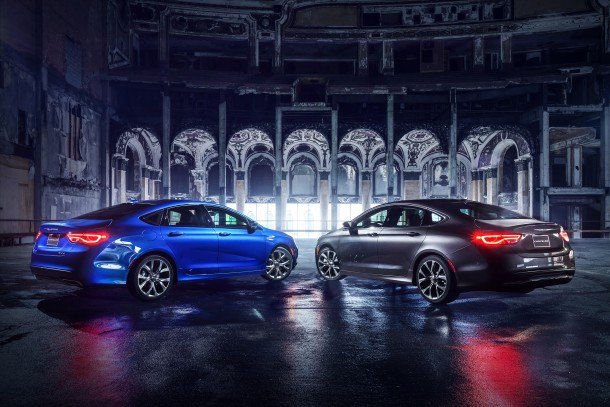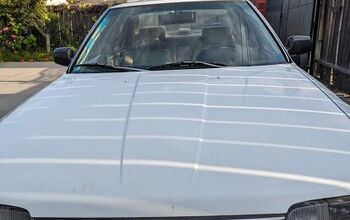Chrysler 200 Demand Dries Up As FCA Tries To Clear 200 Inventory Glut
The plan was straightforward. With demand for conventional midsize cars gradually decreasing and buyers in Fiat Chrysler’s U.S. showrooms increasingly turning to flexible Jeep SUVs, Chrysler 200 production would be temporarily shut down. Inventory was piling up. Inventory needed to be cleared out.
Rather than build more sedans, which would simply be piled up on top of existing unsold 200s, a six-week production hiatus would allow time for 200 supply and demand to realign at more realistic levels.
But the clear-out of those existing, unsold 200s — Automotive News says Chrysler had a 217-day supply of 47,000 200s at the beginning of February — isn’t having any measurable impact on 200 sales. In fact, while FCA wants to see 200s leaving showrooms in order for space to be created for new 200s once production is reignited, demand for the 200 is drying up.
We reported this one month ago, helping to explain why FCA announced in late January that 200 production would be paused. January volume tumbled 63 percent, an 8,957-unit year-over-year decline for FCA’s sole remaining intermediate car.
Surely this was nothing more than an anomaly though, right? Surely surging Fiat Chrysler could sell a swoopy design with a class-leading V6 powerplant and available all-wheel drive in one of America’s most popular new vehicle categories, right? The strange timing of incentives and product mixes and winter storms and GOP debates must have briefly caused 200 buyers to temporarily disappear, right?
Chrysler 200 sales then plunged 58 percent in February 2016, a 9,208-unit year-over-year decrease.
U.S. sales of midsize cars actually increased in February. The segment is slowing, but it’s far from dead. Overall, February sales of new vehicles jumped 7 percent in the U.S.; midsize car volume was up little more than 1 percent, a modest improvement powered by big gains at Chevrolet (Malibu up 53 percent), Ford (Fusion up 12 percent), Honda (Accord up 19 percent), and Hyundai (Sonata up 25 percent).
Total Chrysler brand sales are down 24 percent so far this year, a startlingly poor result for a namesake brand at a fast-growing manufacturer in an exceedingly healthy market. U.S. auto sales last month rose to the highest February level since 2001. It was the best February for FCA/Chrysler Group since 2006. Year-over-year, sales across the FCA conglomerate increased 10 percent.
At the Chrysler brand, however, the losses which have occurred through 2016’s first two months all stem from the 200. In advance of the Pacifica’s arrival, Town & Country volume rose by a quarter to 18,030 through January and February. Sales of the 300 are also up 25 percent, producing the best start to a year for the flagship sedan in three years.
January and February are low-volume months on the auto sales calendar, but the bright spots in FCA’s car division are still worthy of note. Working with the 300’s 25-percent uptick are improvements from the Challenger and Charger, the latter of which is roundly outselling the 200 in America this year.
The list of of FCA products currently outselling the 200 would be too lengthy to list if this was a print publication. Every Jeep, even the the Patriot, Compass, and Renegade. Both minivans. Ram’s lone pickup truck (by nearly six-to-one). The Charger, Dart, Durango, and Journey, too.
Only 3.5 percent of the FCA vehicles sold in January and February were Chrysler 200 sedans.
The car’s midsize market share, rising to 9 percent at this stage of 2015, fell below 4 percent in 2016’s first two months.
One year ago, only 17 nameplates — and only eight cars — were outselling the 200, sales of which had jumped 31 percent year-over-year. But presently, the 200 is America’s 68th-best-selling vehicle and the 24th-best-selling car, a fall from grace typically witnessed only with discontinued cars or when cars are in the midst of transitioning into a new generation.
In the case of Chrysler’s midsize sedan, even if the car had debuted in mid-2014 to industry-wide “best-in-class” declarations, it would still have taken more than a generation for Chrysler to cement a positive reputation. But Chrysler did not introduce a car that was widely praised as best-in-class. Chrysler is not synonymous in the midsize sector with reliability, perceived quality, and long-term durability. And the midsize sector is chock full of buyers who turn most often to the sedans with the most deeply entrenched reputations for reliability.
Fortunately for Fiat Chrysler, none of this appears to relate at all to the company’s ability to succeed with pickup trucks and SUVs. Jeep, Ram, and Dodge’s two utility vehicles, which produced nearly seven out of every ten FCA sales in January and February, collectively produced a 19-percent improvement equal to 36,000 additional sales.
Not only does such a gain offset the loss of 18,000 Chrysler 200 sales, it also offsets the 2,400-unit decline from another FCA namesake product, the Fiat 500.
[Images: Fiat Chrysler Automobiles North America]
Timothy Cain is the founder of GoodCarBadCar.net, which obsesses over the free and frequent publication of U.S. and Canadian auto sales figures. Follow on Twitter @goodcarbadcar and on Facebook.
More by Timothy Cain
Latest Car Reviews
Read moreLatest Product Reviews
Read moreRecent Comments
- Mikey My youngest girl ( now 48 ) dated a guy that had a Beretta with a stick shift. The Dude liked Beer and weed. too much for my liking..I borrowed my buddy's stick shift Chevette and give her short course on driving a manual .. I told her if the new BF has more than 2 beer or any weed ..You drive ...I don't care how many times you stall it, or or of you smoke the clutch . She caught on quite well ,and owned a succession of stick shift vehicles...An as an added bonus she dumped the guy.
- Blueice "Due to regulation/govt backing, China is poised to dominate BEV/battery production, just as they do solar panel production, drone production, etc.Taiwan dominates production of certain types of chips due to regulation/govt backing and we saw how precarious such a situation is (especially with the PRC increasingly becoming aggressive towards Taiwan).That's why regulation/govt backing is aiming to build up local chip manufacturing."BD2, these businesses and or industries are not free market enterprises, buttcorporatist, bent on destroying their competitors with the use of governmentalunits to create monopolies. How safe are world consumers when the preponderance of computer chipsare made in one jurisdiction. Do you what Red China controlling any industry ??And it is well known, concentrated markets control leads to higher prices to end users.
- Master Baiter I told my wife that rather than buying my 13YO son a car when he turns 16, we'd be better off just having him take Lyft everywhere he needs to go. She laughed off the idea, but between the cost of insurance and an extra vehicle, I'd wager that Lyft would be a cheaper option, and safer for the kid as well.
- Master Baiter Toyota and Honda have sufficient brand equity and manufacturing expertise that they could switch to producing EVs if and when they determine it's necessary based on market realities. If you know how to build cars, then designing one around an EV drive train is trivial for a company the size of Toyota or Honda. By waiting it out, these companies can take advantage of supply chains being developed around batteries and electric motors, while avoiding short term losses like Ford is experiencing. Regarding hybrids, personally I don't do enough city driving to warrant the expense and complexity of a system essentially designed to recover braking energy.
- Urlik You missed the point. The Feds haven’t changed child labor laws so it is still illegal under Federal law. No state has changed their law so that it goes against a Federal child labor hazardous order like working in a slaughter house either.




































Comments
Join the conversation
The problem with Chrysler is that it doesn't stand for anything anymore. Chrysler was the upscale answer for MOPAR to compete with lincoln and cadillac (now cadihack after its road rabies styling). Now Chrysler is at a level (or lower) than Honduh or Toyoduh. There is nothing special here. The 200 should have been a Dodge and Chrysler should be working on premium products that are more exclusive (lower volume that can command a higher price tag). Now if Chrysler wants to continue what it is, it needs to get rid of Dodge and consolidate its models into Chrysler and then just be a step up from Dodge's former rancid level). I don't know if Chrysler is premium enough to compete against Kia.
I rented a 200 last summer and it actually wasn’t a bad car, I’ve been in far worse. IMO, the 200 is one of the best looking cars in the midsize segment but Marchionne’s comments to kill the car that was plastered across the internet sealed this cars fate. If I was into midsize vehicle's, the fully loaded 200c would certainly be near the top of my list.